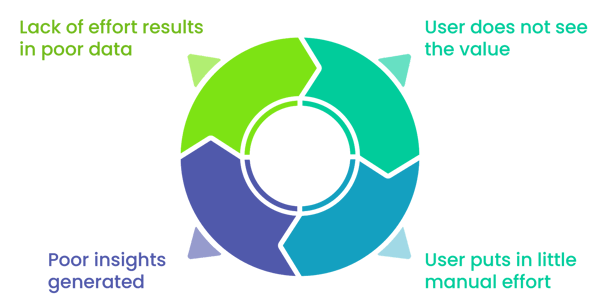September 1, 2023
 by Disha Gupta / September 1, 2023
by Disha Gupta / September 1, 2023

Most organizations rely on sophisticated customer relationship management (CRM) tools to manage their orders and revenue and organize business flows.
CRM solutions modernize sales processes for organizations and improve their customer experience. It empowers salespeople to accelerate the sales cycle and get more control over opportunities.
Organizations are well aware of the fact that the right CRM software can completely transform their sales workflow and accelerate productivity. Unfortunately, investment in a CRM alone doesn’t equal broad user adoption.
CRM adoption is the process of implementing and integrating a CRM system within an organization. It ensures that salespeople use the tool effectively for managing customer interactions, sales processes, and other campaigns.
Only 40% of businesses claim a 90% CRM adoption rate, while the majority of businesses struggle to encourage system adoption. We can conclude that implementing a CRM system in your organization will not always lead to a success story.
To turn the tables around, organizations need to get to the root cause of this failure, that is, low user adoption. The sad truth is that even with the aim of improving efficiency and productivity, CRM projects often fail to translate into real-world usage by the people most likely to benefit from them.
Ineffective CRM adoption can mismanage customer relationships, fail to capture important data and insights, or even lead to a loss of potential customers, leaving unfavorable consequences on your business.
The CRM adoption challenge is difficult to tackle as it’s not just one problem, it’s a series of problems that feed into each other and create a vicious never-ending cycle.

We know that data is the lifeblood of every business, but for it to be of any value to the company, it is critical for a salesperson to input, store, and update accurate data, as well as ensure data quality and integrity.
For instance, after a prospect is discovered, a sales representative has to fill in its detailed info into the CRM, and the same process has to be repeated after each interaction. Logging emails, phone calls, and recording meeting details become a major part of a sales rep’s daily routine which adds a lot of manual data entry tasks to their work which might complicate their job and drive them away from adopting the software.
This is where the vicious cycle begins - sales teams fail to see the CRM value right off the bat, causing them to put in little effort in the data entry stage. Entering the data manually into the CRM is just workplace drudgery for them. According to HubSpot, manual data entry tops the list of CRM adoption challenges, and around 32% of sales reps spend over an hour on data entry every day, which, let’s face it, is not a very good use of their time.
Experts say that salespeople are reluctant to put in the manual effort as they think that the CRM solution is a way of controlling them and is digital evidence that could be used against them in case they fail to reach their goals. Another reason for their resistance could be the complex interface of the application and lack of practical training, which leaves them intimidated by the system.
With a decreased effort, the sales team might input low-quality data or leave out essential data points, causing the CRM to be powered by poor, inaccurate data. Poor data quality can become a huge overhead for companies. In fact, organizations believe that poor data quality is responsible for an average of $15 million loss per year.
Inadequate data makes the CRM system less valuable, thereby decreasing its usage among employees. The poor data also leads to poor insights that provide very little value to the sales and business development teams. This is a huge problem for management as well since, without the data, a manager can’t run reports or conduct analytics on those reports. And without analytics, they fail to answer critical business questions. So the whole point of having a CRM in the first place is actually lost.
With little insight being gained from the inadequate data, the CRM will reinforce the sales team to believe that there’s nothing in it for them. The cycle continues to repeat itself, leaving them to grow more and more disinterested in the tool. It’s not hard to see how this cycle can affect CRM user adoption rates. Most companies don’t fully consider user adoption issues while planning a CRM project, but it is critical for them to build a strong adoption strategy from the very beginning and keep it in focus throughout the CRM lifetime.
To break this vicious cycle of adoption, it is important to understand the challenges and then figure out suitable solutions. So here are some of the most critical CRM adoption challenges.
Most CRM platforms are tailored according to the requirements of sales managers and leaders since they are the key decision-makers in purchase decisions. So to get the deals finalized, suppliers optimize the CRM features that are most suitable for the decision-makers, mainly pertaining to reporting, pipeline visibility, or forecasting. The result of this optimization is that ease of use is compromised, making the CRMs too cumbersome for sales reps to adopt.
Also, the decision-makers do not really understand the real value of the CRM tools and focus more on spending as little as possible. Hence, the CRM might not end up mirroring how sales reps actually wanted to execute the sales strategy, but they are still expected to adopt the tool effectively. In most cases, almost no effort is made by the organizations to make users aware of the tool's background or show them how and why it can help them achieve their KPIs. As a result, the moment they feel uncertain about how to use the tool, they fall back to the traditional methods of getting things done.
The less understanding users have about the benefits of CRM, the more resistant they are toward the change. It’s a sum-total of all this dissatisfaction that tends to impact the user adoption rates.
Businesses rely on certain tools like email or spreadsheets to run a wide variety of day-to-day processes. These tools are the “center of gravity” that define the workflows for a company. When a CRM is introduced, it often ends up competing against these tools for similar tasks.
A CRM is implemented to achieve more consolidated communication and less use of spreadsheets. Failing to achieve these results can be an indication that the team is not using the CRM at the optimum level.
Since employees have been stuck with the old methods for a very long time, they feel comfortable entering the data into the old, familiar spreadsheets rather than putting additional effort into entering data into the new CRM. Most employees prefer traditional methods of getting things done. Another reason for people going back to the traditional methods could be the lack of on-the-go training on how to navigate through the complex interface of a CRM.
Instead of investing in customization and training processes, most companies simply purchase the software and ask the employees to figure it out themselves and expect them to start working right away.
As a result, employees are forced to navigate their way through the complex system, leaving them overwhelmed with the number of steps and features, again forcing them to switch to old methods. They would rather pull data from different sources and work with spreadsheets to make reports because it seems easier than navigating through the complicated CRM that doesn't provide the right training.
Even if some companies take initiatives to develop training programs for their employees to improve adoption rates, the challenge here is that the traditional system education methods aren’t suited for the digital world anymore.
These methods are only setting the company up for failure. Let’s see why:
How an organization decides to roll out a change can either make or break the user adoption efforts. If the organization fails to convey the “what’s in it for you” factor to the users, it might lead to low accountability to use the tool. First impressions matter the most, and if the staff’s first experience with a new CRM fails to meet their needs, people lose confidence in the capability of the software.
Even if the organization tries to make improvements, it would still be a huge challenge to actually change people’s minds and push them to accept the change because they will always hold the first impression in their minds.
In an ideal world, the CRM would have a "guru" who is an expert, a cheerleader, and a 24/7 point of contact for any issues faced by the users. But let’s face it, the world is not ideal, and the guru doesn’t exist. Organizations mostly do not focus on supporting the new software users once the product is implemented, which discourages the employees from adopting it.
Organizations fail to understand that a CRM is not a set-it-and-forget-it system as it is likely to release new features on a regular basis hence constant promotion and support is required throughout its lifecycle. For instance, if a CRM admin needs to add custom objects for better report visibility, without the post-implementation support and lack of testing skills, the admin would modify the solution without checking if the objects reflect the necessary data and increase report visibility. This could lead to wrong data output.
Employees will always have queries and issues while trying to work with the new tool and features. Failing to provide users with enough support at the time causes a lack of enthusiasm leading to a lower adoption rate and underutilization of the product.
So with the well-known challenges, once the platform is selected for a business, what are the CRM best practices that can help ensure a successful implementation? Let’s discuss some targeted strategies and techniques that might help solve user adoption challenges.
Employees play the most significant role in successful CRM implementation. Hence, it is always wise to involve them from the very beginning of the implementation process and exhibit how the new system will reduce their workload. It is critical for organizations to make individual users understand the need for a new system to get the adoption process started off on the right foot.
To tailor the CRM according to user needs, the representative users across the sales hierarchy need to be involved in the software selection and design process. As a gesture for effective user adoption, users should be run through all the features to seek their perspective on the ideal CRM experience. Their inputs will help determine which application and workflow will be best suited to improve sales.
Also, communicating with the staff about the value a CRM will bring to them and tying user adoption with personal growth and development will make users embrace the transformation more easily.
By now, we already know that a CRM is only as good as the data in it. Only by filling it with quality data can the cycle of poor CRM user adoption be broken. But the manual effort is a big part of getting that quality data, which is just a monotonous, boring task for a user that keeps them from seeing the actual benefits of the tool. This is where CRM automation can change the game.
Automating time-consuming data entry and management tasks like customer outreach with a quick email and call logging or email templates with merge fields can help reduce the manual entry efforts and make users see the CRM as a labor-saving tool. Every manual effort reduced by automation translates into lower frustration levels for the users and increased efficiency.
Automation fits into the business workflows and maintains data quality through automatic contact updates while ensuring that users don’t have to change their ways of working just to get the data entered. Automation helps clean up the data, keep it up-to-date, and generate valuable insights that are easily visible and accessible by sales reps.
In addition to data automation, CRM can also be optimized with tools like relationship intelligence automation (RIA). RIA collects, stores, and analyzes customer data from multiple resources like emails or social media and delivers it automatically to the sales team without any manual input. It serves CRM users with workable relationship insights that can help accelerate sales and strengthen customer relationships.
When it comes to the adoption of complex CRM applications like Salesforce, training cannot be just about sending employees to a traditional training class for a few weeks and overwhelming them with too much information at once. Instead, a short, initial training period that focuses on onboarding and a few key processes is the right way to get started with the training plan.
The best digital adoption software can be overlaid with CRM applications (like Salesforce Software) to offer automated continuous learning while onboarding users to the new app. The system helps accelerate Digital Adoption in an organization by placing employees on the front lines and assisting them while working a typical day, providing walkthroughs to tackle practical tasks like adding an opportunity, data entry, data update, etc. DAS enables learning in the flow of work and prevents users from exiting the application to find help.
Digital adoption solutions can help improve CRM user adoption by:
The sales reps should always feel empowered to provide suggestions for improvements in the tool or report a process that is too complex for them. There is nothing more motivating to an audience than knowing that their opinion is valued. It increases engagement and makes them feel more invested in making the implementation successful. Hence, it is vital for organizations to understand the pulse of the users by regularly collecting their feedback and then channeling it to make improvements or add new features in the CRM.
Apart from providing in-app guidance, DAS also enables the monitoring of employee-software interactions as well. This monitoring is done by tracking user behavior, like which CRM features are being used and how, record creation or updation rates, activity completion, open or closed tasks, etc. Such insights can be used to understand software usage, what features the users need more help with and errors, and plug the gap accordingly. This can help improve the adoption metrics and create a better user experience.
CRM is meant to organize data and contacts based on buyer personas, provide reports that give direction to a business, and integrate with other software so it never moves away from the sales process.
CRM is an effective tool that salespeople should not fear. Instead, it’s up to managers to make their teams aware of how it can make their lives easier. It is important to pay attention to what users want, give them the chance to voice any concerns and highlight what’s in it for them to encourage adoption.
The CRM strategies discussed above can help organizations to encourage user adoption because they are all focused on the sales team. All of these aspects run parallel to each other and are tied together for a successful CRM implementation.
A CRM is not a static thing; rather, it is complex and needs to be constantly supported, maintained, and shaped toward refinement. Achieving the desired user adoption rates does not happen overnight; it requires an ongoing investment in improvement and dealing with milestones.
Integrate your CRM with marketing automation software to streamline workflows and facilitate an enhanced customer experience.
Disha Gupta is a content marketer at Whatfix. She helps organizations accelerate digital adoption by spreading awareness through her content. She has a great passion for writing anything and everything from poems to blog posts.
The learning curve in our digital world can be steep, with constant changes and innovations...
 by Hartmut Hahn
by Hartmut Hahn
Imagine you’re tasked with implementing a complex new CRM tool designed to transform your...
 by Jennifer Clark
by Jennifer Clark
Digital transformation initially focused on gaining a competitive advantage over slower...
 by Hartmut Hahn
by Hartmut Hahn
The learning curve in our digital world can be steep, with constant changes and innovations...
 by Hartmut Hahn
by Hartmut Hahn
Imagine you’re tasked with implementing a complex new CRM tool designed to transform your...
 by Jennifer Clark
by Jennifer Clark


